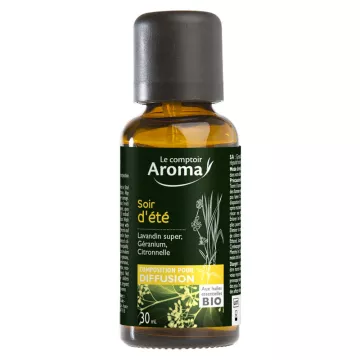

Essential oils in ready-to-use blends are a real treasure trove for your daily well-being. They can be used to diffuse into the air intoxicating, soothing or invigorating scents, according to your needs and desires at the time. Thanks to their aromatherapeutic properties, these oils can help improve your mood, concentration, sleep, breathing and more.
Our diffusion complexes are to be used with one of our essential oil diffusers, nebulizers, fan diffusers or others. Whether you're looking for a moment of relaxation, to banish odors, promote respiratory well-being or purify the air in your home, you'll find a complex to suit your needs. Our essential oil complexes can be diffused at any time of day!
Complexes for diffusion are made up of a combination of several complementary essential oils, acting in synergy and specially designed for atmospheric diffusion. These complexes can be used anywhere (bedroom, office, living room, etc.) to offer you a moment of well-being. They diffuse cleanly, silently and effectively through a diffuser.
Discover our selection of essential oil complexes and choose the one that suits your specific needs (sleep, immune system, anti-mosquito, ambiance, etc.).
The ready-to-use blend saves you the hassle of diluting essential oils and composing a custom blend. Simply pour a few drops into your essential oil diffuser to enjoy their immediate benefits. You can also opt for specific blends according to the needs of each member of your family, or according to the time of day (waking up, work, relaxation, etc.).
At Soin-et-Nature we offer a range of 100% chemotyped essential oil complexes, obtained by steam distillation of plant extracts, to relax, soothe, purify, prevent, stimulate and combine with other treatments. Essential oils have powerful therapeutic properties and are composed of specific aromatic molecules. By combining several essential oils, we obtain a synergy of their active ingredients to optimize their efficacy.
Essential oils penetrate the respiratory tract, providing a soothing or stimulating effect. Not all essential oils can be administered this way: some can cause eye irritation, others have an unpleasant odor or can be irritating to the respiratory tract. The olfactory route is used by diffusion or inhalation.
Atmospheric diffusion of an essential oil not only purifies and/or perfumes a room, but also creates a climate of relaxation. The antiseptic activity of citrus essences is a good way to prevent infections such as the flu or colds. However, some essential oils are highly aggressive to mucous membranes, such as oregano or savory, which are rich in phenols. Others, such as peppermint and wintergreen E.O., are toxic to the nervous system. Not all oils can be used for diffusion.
Diffusion is particularly suitable for nervous problems such as anxiety or insomnia, for purifying a room and for eliminating insects. In the absence of a diffuser, diffuse 4 to 5 drops in a saucer or humidifier near a heat source below 40°C (to avoid denaturing the molecules).
Never diffuse continuously in a closed room, especially in the presence of children, the elderly, asthmatics, allergy sufferers, epileptics, neuro-deficient people or pregnant women (risk of convulsions in the best of cases). Diffusion should last no longer than 10 minutes, no more than 3 times a day, after which the diffusion area should be aired.
In short, essential oils in ready-to-use blends are a simple, fast and effective way to enjoy the benefits of essential oils in your daily environment. So go ahead, embark on the captivating world of essential oils for a healthier, happier life!
Inhalation decongests the respiratory tract and tones facial skin.
Essential oils in ready-to-use inhalation blends are an essential asset for improving health and well-being.
With their unique formulation and perfectly balanced blend, these products deliver fast, long-lasting results. Essential oils, rich in antioxidants, phytonutrients and active ingredients, work synergistically to boost the immune system, relieve aches and pains, calm nerves, soothe respiratory irritationsand offer a truly relaxing experience.
What's more, by using essential oils in ready-to-use blends, you avoid the risk of dosage errors and incorrect mixtures, which can lead to undesirable reactions. Essential oils in ready-to-use blends are also very practical for people who don't have the time or knowledge to make their own blend.
Last but not least, by inhaling essential oils, you can enjoy their benefits immediately, without the potential side effects of taking them orally. It's a simple, fast and effective way to improve your quality of life.
Wet inhalation consists of mixing warm water not exceeding 40°C with 6 drops of E.O. in a bowl, then isolating your face with a towel covering your head over the bowl to inhale the vapors for 3 to 5 minutes. This method is not recommended for asthmatics and/or allergy sufferers. It's best performed in the evening, before bedtime, when you don't have to leave the house, to avoid contact with outside air, cold or pollution, which can irritate the skin and mucous membranes, and thus avoid catching bronchitis or sinusitis. It's essential to keep your eyes closed during inhalation. In addition, dermocaustic essential oils should not be used in this way, as they may cause skin and mucous membrane irritation.
Dry inhalation involves impregnating a tissue with 2 drops of essential oil, then covering the nose with the tissue. A deep inhalation quickly clears the nasal mucosa and helps prevent winter respiratory infections. Essential oils can also be applied to the inside of the wrists before breathing in. This method combines the respiratory route with the general (cutaneous) route. As the wrists are richly vascularized, the essential oil quickly reaches the general circulation, immediately soothing a nervous attack or emotional shock.
Soin-et-Nature offers a wide range of products for diffusing essential oils and enjoying their benefits for your health and well-being. Here are the categories available:
These products for essential oil diffusers, available on Soin-et-Nature, allow you to take full advantage of the aromatic and beneficial properties of essential oils in a natural, harmonious setting.